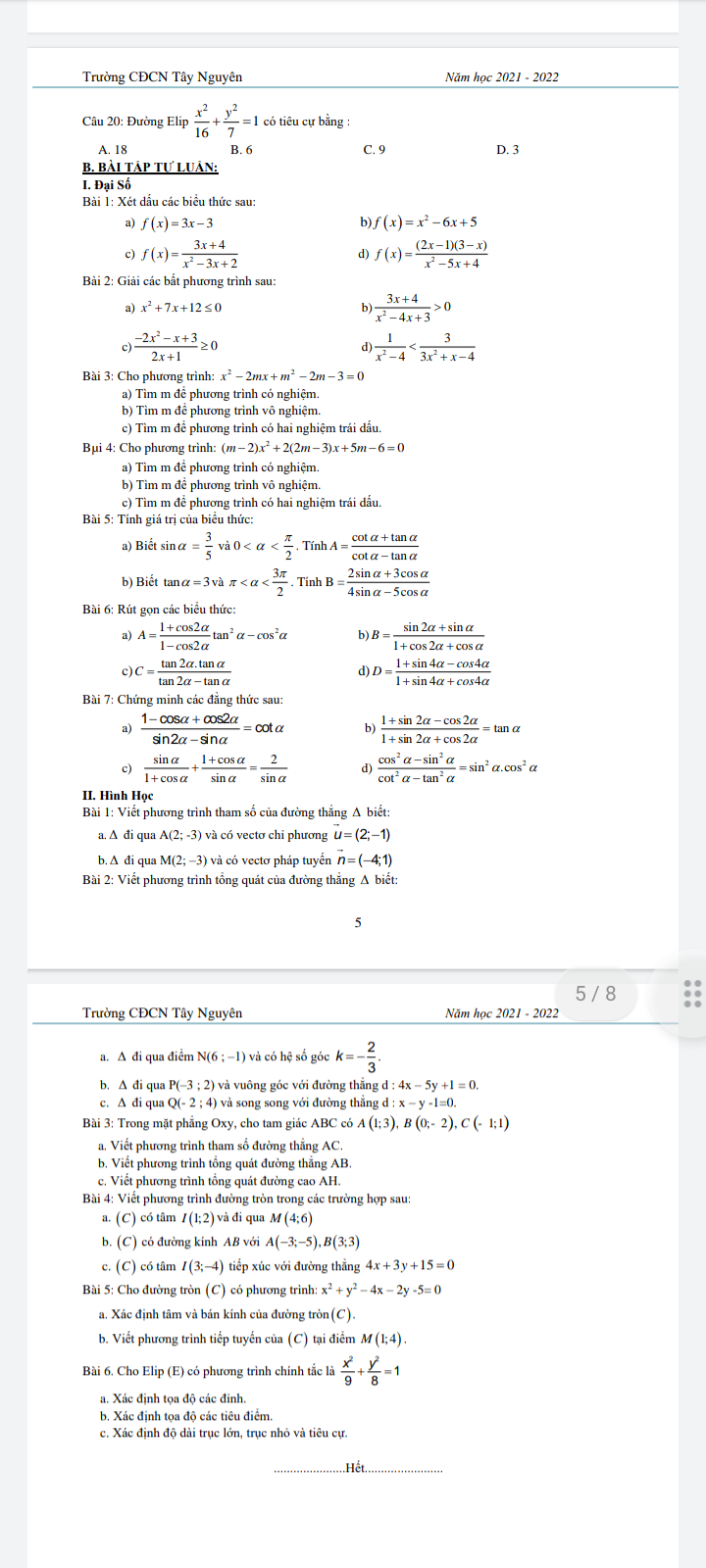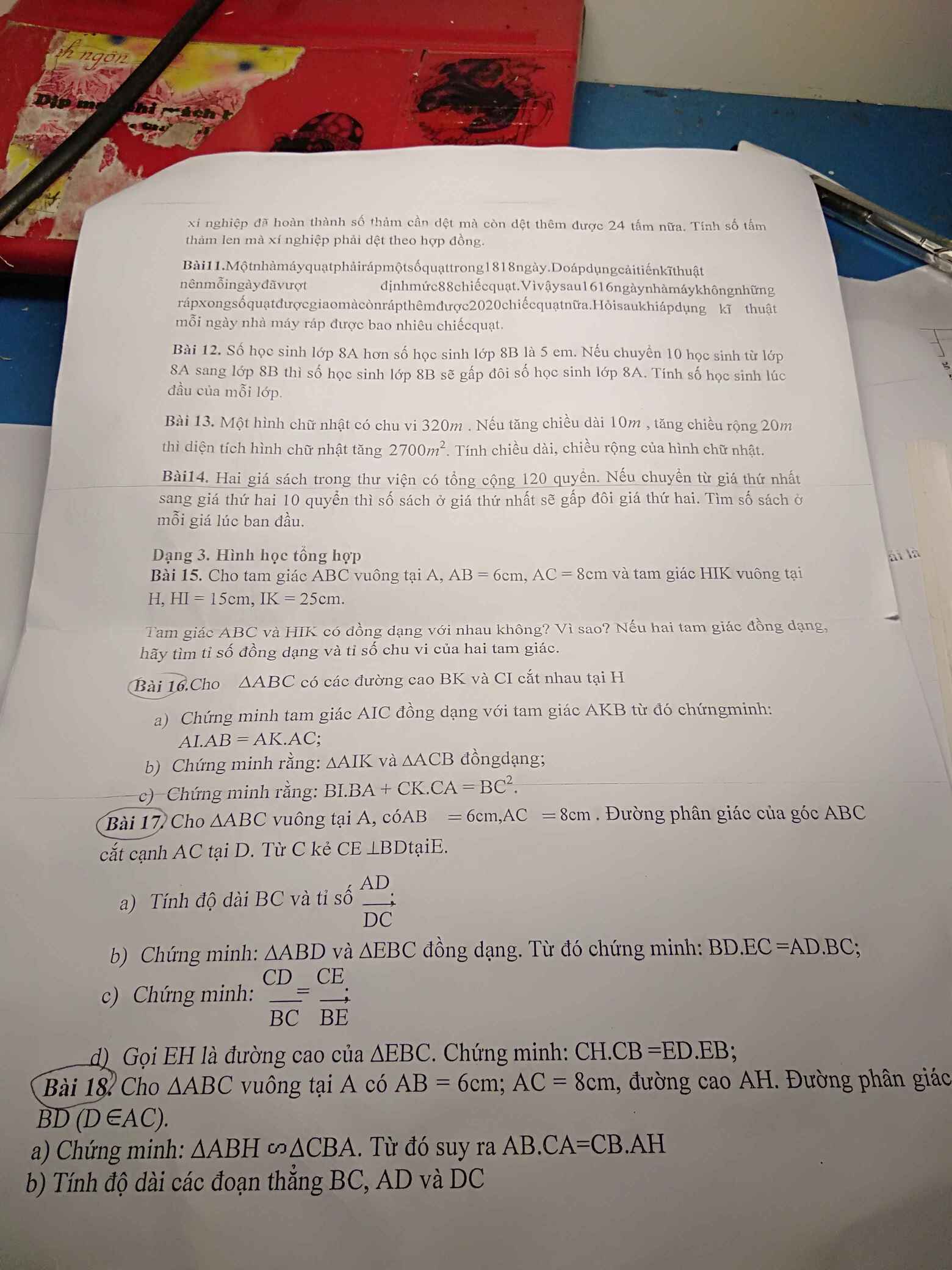
Hãy nhập câu hỏi của bạn vào đây, nếu là tài khoản VIP, bạn sẽ được ưu tiên trả lời.


1.1
Pt có 2 nghiệm trái dấu và tổng 2 nghiệm bằng -3 khi:
\(\left\{{}\begin{matrix}ac< 0\\x_1+x_2=-3\end{matrix}\right.\)
\(\Leftrightarrow\left\{{}\begin{matrix}2\left(m+2\right)< 0\\\dfrac{2m+1}{m+2}=-3\end{matrix}\right.\)
\(\Leftrightarrow\left\{{}\begin{matrix}m< -2\\m=-\dfrac{7}{5}\end{matrix}\right.\)
\(\Rightarrow\) Không tồn tại m thỏa mãn
b.
Pt có nghiệm kép khi:
\(\left\{{}\begin{matrix}m+2\ne0\\\Delta=\left(2m+1\right)^2-8\left(m+2\right)=0\end{matrix}\right.\)
\(\Leftrightarrow\left\{{}\begin{matrix}m\ne-2\\4m^2-4m-15=0\end{matrix}\right.\)
\(\Rightarrow\left[{}\begin{matrix}m=\dfrac{5}{2}\\m=-\dfrac{3}{2}\end{matrix}\right.\)

\(\Leftrightarrow\left\{{}\begin{matrix}5x^2+5y^2+5xy-15=0\\2x^2+2y^2-xy+x+y=5\end{matrix}\right.\)
Trừ vế cho vế của pt trên cho pt dưới:
\(3x^2+3y^2+6xy-\left(x+y\right)-15=-5\)
\(\Leftrightarrow3\left(x+y\right)^2-\left(x+y\right)-10=0\)
\(\Rightarrow\left[{}\begin{matrix}x+y=2\\x+y=-\dfrac{5}{3}\end{matrix}\right.\)
\(\Rightarrow\left[{}\begin{matrix}y=2-x\\y=-\dfrac{5}{3}-x\end{matrix}\right.\)
Thay vào pt đầu giải pt bậc 2 một ẩn như bt

5:
a: (C): x^2-4x+4+y^2-2y+1-9=0
=>(x-2)^2+(y-1)^2=9
=>R=3; I(2;1)
b: vecto IM=(-1;3)
=>(d) có VTPT là (-1;3)
Phương trình d là;
-1(x-1)+3(y-4)=0
=>-x+1+3y-12=0
=>-x+3y-11=0

Pt đã cho có nghiệm duy nhất khi và chỉ khi:
\(m^2-4\ne0\Rightarrow m\ne\pm2\)
\(\Rightarrow\) Có \(5-\left(-5\right)+1-2=9\) giá trị nguyên của m


Lời giải:ĐK: $x\in\mathbb{R}$
PT $\Leftrightarrow 5\sqrt{x^2+5x+28}=x^2+5x+28-24$
Đặt $\sqrt{x^2+5x+28}=a(a\geq 0)$ thì pt trở thành:
$5a=a^2-24$
$\Leftrightarrow a^2-5a-24=0$
$\Leftrightarrow (a+3)(a-8)=0$
Vì $a\geq 0$ nên $a=8$
$\Leftrightarrow x^2+5x+28=64$
$\Leftrightarrow x^2+5x-36=0$
$\Leftrightarrow x=4$ hoặc $x=-9$

ĐKXĐ: \(-1\le x\le4\)
\(\Leftrightarrow\left(x-3\right)\sqrt{1+x}-\left(x-3\right)+x-x\sqrt{4-x}=2x^2-6x\)
\(\Leftrightarrow\left(x-3\right)\left(\sqrt{1+x}-1\right)+x\left(1-\sqrt{4-x}\right)=2x^2-6x\)
\(\Leftrightarrow\dfrac{x\left(x-3\right)}{\sqrt{1+x}+1}+\dfrac{x\left(x-3\right)}{1+\sqrt{4-x}}=2\left(x^2-3x\right)\)
\(\Leftrightarrow\left[{}\begin{matrix}x^2-3x=0\Rightarrow x=...\\\dfrac{1}{\sqrt{1+x}+1}+\dfrac{1}{1+\sqrt{4-x}}=2\left(1\right)\end{matrix}\right.\)
Xét (1), do \(VT< \dfrac{1}{1}+\dfrac{1}{1}=2\Rightarrow VT< VP\Rightarrow\left(1\right)\) vô nghiệm
Vậy ...









 hộ em với
hộ em với 
 iải chi tiết hộ em với
iải chi tiết hộ em với 
 Giải hộ em với ạSắp thi rồi
Giải hộ em với ạSắp thi rồi Giải chi tiết hộ em với ạ
Giải chi tiết hộ em với ạ 
Bài 3.7
a: Thay x=2 vào y=3x+2, ta được:
\(y=3\cdot2+2=8\)
Thay y=2 vào y=-3x+4, ta được:
-3x+4=2
=>-3x=-2
=>x=2/3
Vì (d) đi qua (2;8) và (2/3;2) nên ta có hệ phương trình:
\(\left\{{}\begin{matrix}2a+b=8\\\dfrac{2}{3}a+b=2\end{matrix}\right.\Leftrightarrow\left\{{}\begin{matrix}a=\dfrac{9}{2}\\b=-1\end{matrix}\right.\)
b: Tọa độ giao điểm của hai đường \(y=-\dfrac{1}{2}x+1;y=3x+5\) là:
\(\left\{{}\begin{matrix}3x+5=-\dfrac{1}{2}x+1\\y=3x+5\end{matrix}\right.\Leftrightarrow\left\{{}\begin{matrix}\dfrac{7}{2}x=-4\\y=3x+5\end{matrix}\right.\Leftrightarrow\left\{{}\begin{matrix}x=-\dfrac{8}{7}\\y=-\dfrac{24}{7}+5=\dfrac{11}{7}\end{matrix}\right.\)
Vì (d)//y=1/2x nên a=1/2
Vậy: (d): y=1/2x+b
Thay x=-8/7 và y=11/7 vào (d), ta được:
\(b-\dfrac{1}{2}\cdot\dfrac{8}{7}=\dfrac{11}{7}\)
hay b=15/7